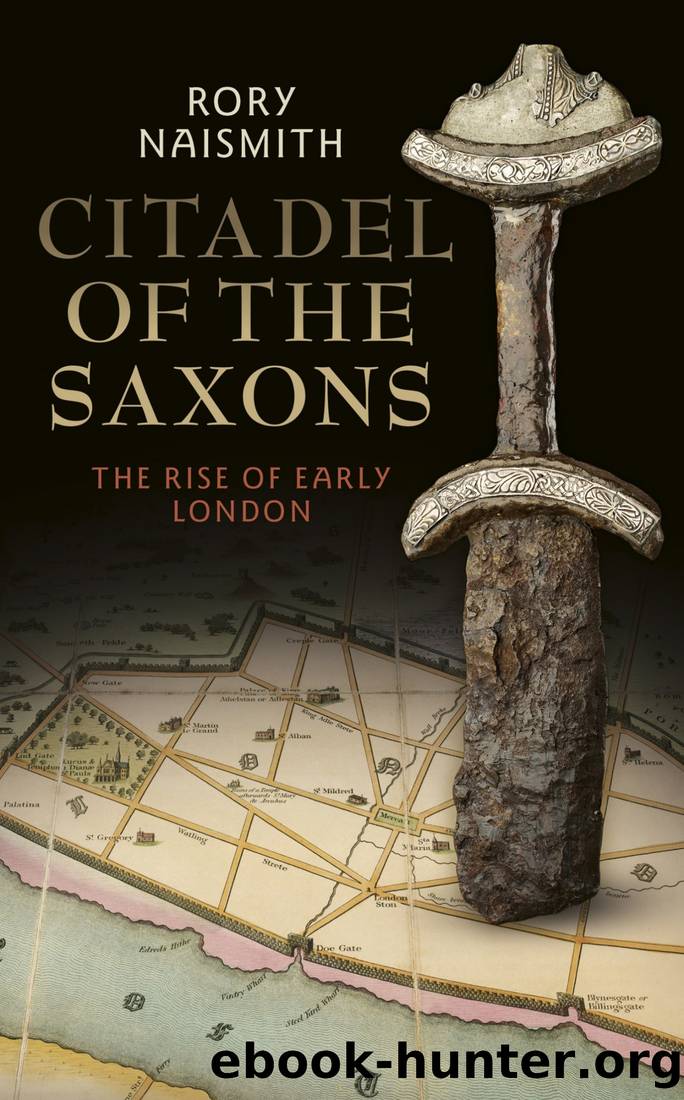Citadel of the Saxons by Rory Naismith;

Author:Rory Naismith; [Naismith;, Rory]
Language: eng
Format: epub
Tags: History;River Thames;medieval London;Londinium;Lundenwic;Lundenburgh;Anglo-Saxons
ISBN: 9781788312226
Publisher: Bloomsbury
Published: 2019-03-27T15:43:40+00:00
âConclusion: London and the Kingdom in the Tenth Century
The tenth century was Londonâs era of consolidation. It probably only developed beyond its Alfredian roots slowly, with fires and floods bringing frequent destruction and rebuilding. Grand buildings could be erected, but might be torn down and recycled in a matter of decades. One did not need to go far before encountering open fields, forests and marshes, which the wealthier and more bellicose Londoners would gamely traverse as the peace-gild pursued suspected thieves. London was firmly integrated into the economy of southern England, and at this stage did most of its business up rather than down the Thames, with inland areas such as Oxfordshire, to judge by the pottery found in the city.57
Across the kingdom, fortified nuclei of government and defence multiplied. Some were completely new, but others absorbed various kinds of pre-existing central places such as minsters or élite estates.58 Although the result was a large complement of what contemporaries called byrg, or boroughs, only a portion of them could be described as urban at this stage: that is to say, supporting a relatively large and permanent population engaged in more than just agriculture. Some would come into their own in the later tenth or eleventh century, forming the nuclei of many small towns, but, archaeologically, just a few of the tenth-century boroughs besides London have produced evidence of substantial activity.59 All had Roman roots, albeit with different fates in the centuries that followed. The group includes a few which had been part of the urban landscape for centuries, such as Canterbury and York,60 as well as others which had effectively only grown up since the late ninth century, among them Chester, Lincoln and Winchester.61 All had their own distinct character. London had inherited size and prestige from earlier times, as well as an advantageous location that channelled river and road traffic, whereas Winchester benefited from more consistent and prominent royal presence, as well as two major monastic establishments. York was home to an archbishop, served as a hub of North Sea trade, and was for a long time the centre of a powerful viking kingdom. Chester, in turn, derived much of its success from access to the Irish Sea.
Within this cohort, Londonâs profile was consistently high, as indicated by the number of moneyers it was assigned in comparison to other towns under Ãthelstan. It had an unusually strong communal identity, manifested in the peace-gild. One other gauge of its prominence is the presence of London in the royal itinerary. It was occasionally selected for royal gatherings (sometimes known in older literature as meetings of the witan): once under Edmund, and with increasing frequency under Edgar.62 Close to London, Kingston upon Thames in Surrey emerged as a favoured site for royal ceremonial, including the consecration of several kings from Ãthelstan in 925 to Ãthelred II in 979.63 There are other hints at the cityâs importance on a national level. In a collection of miracle stories put together by a monk named
Download
This site does not store any files on its server. We only index and link to content provided by other sites. Please contact the content providers to delete copyright contents if any and email us, we'll remove relevant links or contents immediately.
Kathy Andrews Collection by Kathy Andrews(11343)
The remains of the day by Kazuo Ishiguro(8418)
Paper Towns by Green John(4812)
Spare by Prince Harry The Duke of Sussex(4806)
Industrial Automation from Scratch: A hands-on guide to using sensors, actuators, PLCs, HMIs, and SCADA to automate industrial processes by Olushola Akande(4633)
The Body: A Guide for Occupants by Bill Bryson(4599)
Machine Learning at Scale with H2O by Gregory Keys | David Whiting(3668)
Be in a Treehouse by Pete Nelson(3654)
Harry Potter and the Goblet Of Fire by J.K. Rowling(3619)
Never by Ken Follett(3550)
Goodbye Paradise(3463)
The Remains of the Day by Kazuo Ishiguro(3148)
Into Thin Air by Jon Krakauer(3135)
The Cellar by Natasha Preston(3080)
The Genius of Japanese Carpentry by Azby Brown(3045)
Fairy Tale by Stephen King(2976)
120 Days of Sodom by Marquis de Sade(2947)
Drawing Shortcuts: Developing Quick Drawing Skills Using Today's Technology by Leggitt Jim(2943)
The Man Who Died Twice by Richard Osman(2824)
